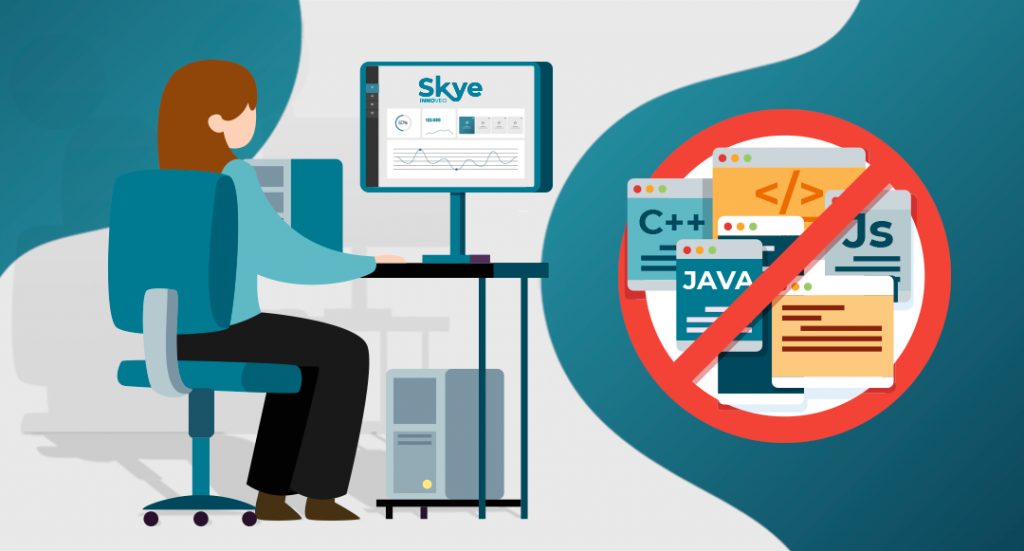Join the No- Code Movement: Questions About No-Code Development You Always Wanted to Ask
If you are in the tech, insurance, or finance industry, chances are you have already heard people talking about no-code development. But what exactly is no-code and how can your company benefit from this? You’ve probably also wondered, is it really possible to develop customizable digital platforms without any coding required?
To address that, I identified the three most frequently asked questions my prospective clients tend to ask about no-code solutions.
1. What Does No-Code Mean and Why It Is the Future of Enterprise-Level Software Development?
No-code development is a method of configuring and bringing complex applications to life without needing any programming knowledge. The main benefit of no-code is the reduction of time and IT expertise required to translate an idea into an MVP (Minimum Viable Product) or an application that people can readily use.
In today’s insurance ecosystem, companies are investing significant funds into innovation labs with agile methodologies. The need to work on MVPs is now becoming relevant at all levels. Therefore, speed and flexibility are critical success factors, especially when it comes to altering or evolving MVPs.
By using a no-code platform, you’ll no longer need 10 programmers for 6-months to build new features into your existing infrastructure. Instead, the configuration of improvements can be done in weeks.
In short, with no-code, you can deliver robust solutions quickly, simply and flexibly, starting with an MVP and continuously extending and launching them in iterations, with the best benefit-cost ratio (BCR) for your company.
2. What Is the Difference Between No-Code and Low-Code Development?
It is fairly common that people find it confusing to differentiate the two terms. Even one of the biggest analyst firms, Gartner, considers no-code platforms as part of the low-code sphere in their recent Magic Quadrant for Enterprise Low-Code Application Platforms, 2019 (LCAP). However, if your business wants to move away from traditional development methods, it is important that you understand the difference between the two paths you can take.
Simply put, low-code allows developers to design applications with minimum hand-coding. While it could be much faster than traditional development, it still requires IT knowledge and coding skills and a qualified development team.
On the other hand, no-code solutions enable practically anybody to create application software through graphical user interfaces and configuration, without any kind of computer programming. This way, you can drastically decrease your IT department’s backlog, and deliver solutions faster with fewer resources.
3. Is It Possible to Develop Applications Without Any Coding and Still Meet Specific Business Requirements?
The answer is absolutely yes. With drag-and-drop components and the complex interface customization these platforms usually have, both developers and non-developers can quickly assemble customized workflows and functionalities. In other words, no-code allows your team to maximize the potential of agile development and to create tailor-made solutions for your business.
In addition, because no-code platforms are capable of designing business processes and workflow applications at a large scale, they are a perfect choice for enterprise-level businesses where complexity and customization are equally important elements.
No-Code Is a Necessity, Not a Distruption
In my experience working with digital transformation teams around the world, unfounded fears, or even the lack of knowledge about no-code solutions used to limit the discussion of this software development approach. Fortunately, we now see this scenario changing.
As this recent pandemic taught us, those who can react to changes faster and grow their business to be more resilient will have a competitive advantage in the market.
In the post-COVID-19 economy, adapting no-code or low-code platforms won’t be a question of disruption, but rather a natural industry evolution, a matter of business survival.
If you haven’t had the chance to explore no-code solutions yet, I encourage you to start your research and experiment with this approach in your projects.
Still more questions about no-code? Contact us! marketing@innoveo.com
Author: Cristiano Moraes da Silva, Head of Business Development for Latam at Innoveo


